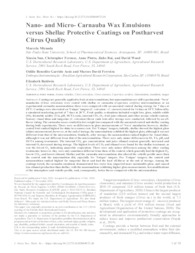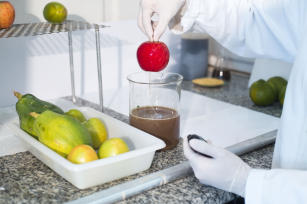Nano- and Micro- Carnauba Wax Emulsions versus Shellac Protective Coatings on Postharvest Citrus Quality.
Nano- and Micro- Carnauba Wax Emulsions versus Shellac Protective Coatings on Postharvest Citrus Quality.
Summary: Coatings are generally applied to fruit as microemulsions, but nanoemulsions are still experimental. ‘Nova’ mandarins (Citrus reticulata) were coated with shellac or carnauba (Copernica cerifera) microemulsions or an experimental carnauba nanoemulsion; these were compared with an uncoated control during storage for 7 days at 20 °C. Coatings were also tested on ‘Unique’ tangors (C. reticulata × C. sinensis) stored for 14 days at 10 °C followed by a simulated marketing period of 7 days at 20 °C. Fruit quality evaluations included weight loss, gloss, soluble solids (SS), titratable acidity (TA), pH, SS/TA ratio, internal CO2, O2, fruit juice ethanol, and other aroma volatile content. Sensory visual shine and tangerine (C. reticulata) flavor rank tests after storage were conducted, followed by an off-flavor rating. The carnauba waxes resulted in less weight loss compared with the uncoated control and shellac coating during both experiments. There were no differences in gloss measurements of ‘Nova’ mandarins; however, shellac-coated fruit ranked highest for shine in a sensory test. For ‘Unique’ tangors, initially, shellac showed the highest gloss (shine) measurement; however, at the end of storage, the nanoemulsion exhibited the highest gloss, although it was not different from that of the microemulsion. Similarly, after storage, the nanoemulsion ranked highest for visual shine, although it was not different from that of the microemulsion. There were only minor differences in SS, TA, pH, and SS/TA among treatments. The internal CO2 gas concentration and juice ethanol content generally increased and internal O2 decreased during storage. The highest levels of CO2 and ethanol were found for the shellac treatment, as was the lowest O2, indicating anaerobic respiration. There were only minor differences among the other coating treatments; however, they were only sometimes different from those of the control, which generally had the highest O2, lowest CO2, and lowest ethanol. Shellac and the carnauba microemulsion also altered the volatile profile more than the control and the nanoemulsion did, especially for ‘Unique’ tangors. For ‘Unique’ tangors, the control and nanoemulsion ranked highest for tangerine flavor and had the least off-flavor at the end of storage. Among the coatings tested, the carnauba emulsions demonstrated less water loss, imparted more sustainable gloss, and caused less ethanol production than shellac, with the nanoemulsion exhibiting higher gloss measurements, less modifications of the atmosphere and volatile profile, and, consequently, better flavor compared with the microemulsion.
Publication year: 2021
Types of publication: Journal article
Unit: Embrapa Instrumentation
Keywords: Aroma volatiles, Mandarin, Tangor
Observation
Some of Embrapa's publications are published as ePub files. To read them, use or download one of the following free software options to your computer or mobile device. Android: Google Play Books; IOS: iBooks; Windows and Linux: Calibre.
Access other publications
Access the Agricultural Research Database (BDPA) to consult Embrapa's full library collection and records.
Visit Embrapa Bookstore to purchase books and other publications sold by Embrapa.


